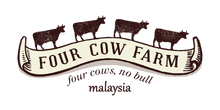The Four Cow Farm Guide To Baby Skincare
Have you ever wondered what goes into the bottles of lotion, oil and wash we pour onto the skins of our little ones on a daily basis? From washes to lotions to oils, most babies have their skins slathered with baby skincare products from the day they are born.
Yet, read almost any listing of skincare ingredients at the back of a bottle, and it’s enough to make anyone’s head swim! How can mums and dads make sense of it all? Here’s a start. Welcome to Four Cow Farm’s guide to deciphering what actually goes into baby skincare and how to make the best choices for your little ones. Because when it comes to caring for baby skin, our motto is always to keep it simple, natural and safe. That’s all baby skin (or any skin) needs!
Step 1. Know which claims are regulated (and which are not) ‘Hypoallergenic’, ‘dermatologically tested’, ‘clinically tested’, ‘no-tears formula’, ‘fragrance-free’ - many of the claims on the lotions and washes we buy are just that, claims. Claims which aren’t regulated, investigated or substantiated by governments or regulatory authorities. Even the terms ‘natural’ and ‘organic’ are regulated in their use only in certain countries and their application (according to each country’s laws) often allows for loopholes and gaps in a product’s ingredients, which can allow suspicious chemicals and synthetic ingredients in. So your best bet? The ingredients list - the only thing that (almost) never lies!
Step 2. Learn to identify the most commonly used petroleum ingredients The vast majority of commercial brands of baby skincare contain petroleum derivatives. Yes, you read that right - petroleum derivatives, i.e. from crude oil. Some of the more common ones are Mineral Oil a.k.a. Paraffinum Liquidum (which most baby oils are made from, with a bit of synthetic fragrance thrown in; read on to learn more about fragrances), Petrolatum a.k.a. Petroleum Jelly, Propylene Glycol, PEGs (Polyethylene Glycol), Polysorbates (usually followed by a number) and DEA/MEA/ TEA. The reason they’re used? They’re cheap, abundant and can last pretty much forever on the shelf. The downside? At best, they’re at risk of being contaminated with carcinogens during manufacturing and are linked to the rise in allergies. At worse, they are themselves carcinogens and are known toxins which are applied direct to the skin on a daily basis. And if that’s not enough, they’re terrible for our earth!
Step 3. Be concerned about the types of preservatives used
Preservatives are necessary to extend a product’s shelf life but there is a huge spectrum of preservatives used (from natural to synthetic) and some have come under a cloud of suspicion. Parabens (such as methylparaben, ethylparaben, butylparaben and propylparaben) have been linked to tumours in the breast and skin, and a possible role as ‘endocrine disruptors’ in mimicking hormones. Phenoxyethanol - a preservative commonly used in natural and organic products - is known to depress the central nervous system and cause vomiting and diarrhoea when ingested by infants. Benzyl Alcohol - another commonly used preservative in mainstream and natural products is known to be toxic to newborns. The worrying thing? These preservatives are commonly found in products meant for babies. If in doubt, always check the expiry date! The longer the expiry date (more than 2-and-a-half years is a clue) and it’s likely what you’re holding contains strong preservatives!
Step 4. Avoid unnecessary fragrances
Let’s begin with synthetic fragrances - which make up most of the fragrance ingredients in skincare products. The vast majority are synthetic compounds derived from - you guessed it - petroleum, as well as coal tar. These include VOCs (volatile organic compounds) linked to cancer, birth defects, central nervous system disorders and allergic reactions. Research has shown that these airborne chemicals have direct access to the brain and our internal systems through the nasal passages. Essential oils, used in many natural products for their fragrance, have been shown to emit similar chemicals when overused. The worst thing? Fragrances are protected as ‘trade secrets’ so manufacturers aren’t required to list what goes into them!
Step 5. Start reading labels and choose ingredients you recognise
A good rule of thumb is if it doesn’t sound like something you’d like to put in your mouth, it’s probably better off not on your or your little one’s skin. We apply lotions, washes and creams to our skin (our single largest organ!) every single day and these often contain ingredients that are questionable at best. Even some naturally-derived ingredients are less beneficial than they appear. Sulphates (such as sodium or ammonium lauryl/laureth sulphate) and cocamidopropyl betaine, both derived from coconut oil, are known to irritate the skin and cause allergic reactions. Cocamide DEA/MEA are known skin irritants and potential carcinogens. Lauryl glucoside and decyl glucoside (both derived from vegetable sources) have only recently been tested for safety. The best test of all? Do your own searching (www.cosmeticsdatabase.com is a great start, funded by the Environmental Working Group, an independent body). After all, the more you know about what goes into your skincare, the more you know about what’s going into your little ones, and you.

